|
1891
Herman Ganswindt, in Berlin, draws up the first designs for a spaceship using solid-propellant rockets.
1900
Roman Baron von Gostkowski publishes one of the earliest scientific discussions of space travel in the Viennese magazine Die Zeit.
1903
The Russian Konstantin Tsiolkovsky publishes his theoretical study of rocket fuels and rocket motor efficiency, and proposes using liquid hydrogen and liquid oxygen as propellants.
The Wright brothers of Dayton, Ohio become the first people to demonstrate sustained flight of a heavier-than-air machine under the complete control of the pilot.
1919
In America, Robert Hutchings Goddard publishes a 69-page paper on his research activities, entitled A Method of Reaching Extreme Altitudes.
1923
Hermann Oberth's book, The Rocket into Interplanetary Space, establishes most of the basic theories of space flight.
1925
A detailed thesis, The Possibility of Reaching Celestial Bodies, is published by Walter Hohmann of Essen, Germany. It gives detailed calculations for interplanetary orbits.
1926
Goddard launches the world's first successful liquid-propellant rocket in Massachusetts.
1927
The first active astronautical society, the Verein für Raumschiffahrt, is formed in Germany.
1928
In Austria, Baron Guido von Pirquet proposes a system of three space stations orbiting Earth, while his countryman Herman Noordung gives engineering plans for such a station. Meanwhile, another Austrian, Franz A. von Ulinski, publishes an advanced plan for a space vehicle with an electric propulsion system.
In France, Robert Esnault-Pelterie publishes the book The Exploration of the Upper Atmosphere with Rockets and the Possibility of Interplanetary Flights.
1929
Oberth publishes Roads to Space Travel, still called "the most important theoretical work on the subject."
In Russia, the Group for Investigation of Reaction Motion is organized.
1930
The American Interplanetary Society (later called the American Rocket Society, and still later the American Institute of Aeronautics and Astronautics) is formed.
Oberth's Kegeldüse, a theoretically ideal rocket combustion chamber, using liquid oxygen and gasoline, is fired on a test stand.
1932
The German Ordnance Corps starts systematic government-sponsored rocket research under Walter Dornberger and Wernher von Braun.
1933
Eugen Sänger publishes his fundamental investigations into rocket engines in the book Raketenflugtechnik (Rocket Flight Engineering) in Munich.
1934
In Germany the Von Braun-Dornberger group fires the first models in a new series of rockets - the Aggregate 2, or A-2, forerunner of the A-4, later called V-2.
1936
The Guggenheim Aeronautical Laboratory of the California Institute of Technology starts investigations of sounding rockets under Theodore von Karman.
1939
The first true turbine-equipped jet aircraft, the Heinkel He 178, piloted by Erich Warsitz is flown in Germany.
1941
In Germany, the rocket-powered Me 163 Komet sets a new world speed record of 1,004.5 km/h.
1942
In its first successful flight, a German V-2 rocket sets new records for velocity (Mach 5) and altitude (85 kilometers).
1944
Caltech gets a go-ahead for high-altitude rocket research and fires its first rocket, Private A, later in the year.
The first German V-2 rockets become operational and are fired against Paris and London.
1945
The first vertical manned rocket flight is conducted in Germany in a Bachem-Natter rocket airplane; in the resulting crash, test pilot Lieutenant Siebert is killed.
The U.S. Secretary of War approves establishment of White Sands Proving Ground.
The Caltech group fires a liquid-propellant WAC Corporal.
1946
The first launch of a captured V-2 for high-altitude research is carried out at White Sands.
Scientific Research Institute No. 88 (NII-88) is established to develop Soviet ballistic missiles. Sergei Korolev is appointed chief designer of Department No. 3, the unit in charge of the V-2 program.
The U.S. Air Force Missile Development Center at Holoman Air Force Base begins biological experiments directed towards a man-in-space program, sending up a balloon with fungus spores to expose them to cosmic radiation.
1947
The Bell XS-1 (later shortened to X-1) rocket research plane, piloted by Captain Charles E. Yeager, flies faster than the speed of sound.
1948
The Soviet Union performs the first tests of its R-1 missile, a Soviet made copy of the V-2.
A four kilogram rhesus monkey named Albert is sent up in a V-2 nose cone at White Sands.
The U.S. conducts flight tests of the MX-774 missile, incorporating many design innovations that will be used on the Atlas missile.
In a year-end report, Secretary of Defense James Forrestal disclosed U.S. space-satellite studies.
1949
A V-2-plus-WAC Corporal combination fired from White Sands reaches outer space - 400 kilometers up.
The first large American rocket, Viking, is launched from White Sands.
President Truman signs a bill providing a 8,000-kilometer guided missile test range at Cape Canaveral, Florida.
1950
The first missile is fired from Cape Canaveral.
The First International Astronautical Congress meets in Paris.
The Soviet government authorizes a research program to study long-range ballistic missiles.
1951
During the Second International Astronautical Congress in London, the International Astronautical Federation (IAF) is formed.
A monkey and eleven mice go safely to 72,000 meters inside a U.S. Aerobee rocket.
1954
The Soviet government authorizes full-scale development of the R-7 ICBM.
The U.S. Air Force announces the decision to proceed with Atlas ICBM development.
1955
Tyuratam, also known as Baikonur, located in Kazakhstan is established as the 5th Scientific and Research Test Range (NIIP-5).
The feasibility of a rocket engine developing a million pounds of thrust in a single chamber established at Rocketdyne.
The U.S. Air Force approves proposals to begin work on an ICBM alternative to Atlas, which will become Titan.
President Eisenhower initiates the satellite program for the International Geophysical Year.
The U.S. Atomic Energy Commission (AEC) approves plans for the study and development of nuclear power for rocket propulsion.
1956
The director of Russia's Aero-Medical Research Center reports on experiments sending up dogs in sounding rockets.
Construction begins on the Jiuquan Satellite Launch Center in northwest China.
The Soviet space and ballistic missile tracking network is established.
A U.S. Jupiter C rocket sends a payload to a range of 5,300 kilometers and an altitude of 1,100 kilometers.
The first test shot in the U.S. satellite program, a Viking, is sent up to test telemetry equipment.
1957
In May, the Soviet Union attempts the first launch of an R-7 ICBM, unsuccessfully.
In June, the U.S. attempts the first launch of an early model Atlas A, unsuccessfully.
Soviet Premier Khrushchev announces a successful ICBM flight in August over a range of 6,000 kilometers.
The Soviet Union launches the first artificial satellite of Earth, Sputnik 1, on October 4.
In November, the Soviet Union launches Sputnik 2, the first satellite to carry a living animal, a dog named Laika.
The United States first attempt to launch an artificial satellite, Vanguard, results in an explosion on the launch pad.
1958
Explorer 1, the first successful U.S. satellite, is launched on January 31. An instrument package provides evidence of high altitude radiation surrounding Earth - the first major scientific discovery of the space age.
The first successful launch of an Atlas B, America's first ICBM.
The U.S. Advanced Research Project Agency formally initiates what will become the Saturn project.
The U.S. attempts the first launch of a lunar probe, Pioneer 0, unsuccessfully.
The Soviet Union attempts its first launch of a lunar probe, Luna, unsuccessfully.
The National Aeronautics and Space Administration (NASA) is formed from the National Advisory Committee on Aeronautics (NACA) and other agencies.
Project Mercury, the first U.S. space flight program, is established.
The U.S. fires the first missile from its west coast launch site at Vandenburg Air Force Base.
1959
The Soviet Union launches Luna 1 in a lunar impact attempt; the spacecraft goes into solar orbit after a 5,000 kilometer fly-by. First direct observations of the solar wind.
Rocketdyne is awarded a full research and development contract for the F-1 engine.
The U.S. launches Pioneer 4, which flies by the Moon at a distance 60,000 kilometers into solar orbit.
NASA announces the selection of its first group of seven astronauts, the "Mercury 7".
The first experimental reactor, Kiwi-A, in the U.S. nuclear space rocket program is operated successfully.
The Soviet Luna 2 probe successfully completes the first lunar impact.
The Soviet Luna 3 probe returns the first pictures of the lunar far side with 70% photo coverage.
Plesetsk, in northern Russia, becomes the world's first operational ICBM site.
1960
The U.S. completes its first successful test launch of a two-stage Titan I ICBM.
The initial group of twenty Soviet cosmonauts is chosen from Air Force jet pilots.
The U.S. launches Pioneer 5, the first deep-space probe, which returns data from a distance of 36.2 million kilometers.
The U.S. launches TIROS-1, the world's first successful weather satellite.
Sputnik 4 is an unmanned test of the Soviet Vostok spacecraft.
The United States' lunar landing project is formalized as Project Apollo.
Mercury-Atlas 1 is the first unmanned qualification flight of the spacecraft Atlas combination, considered a failure.
The U.S. recovers the first object returned from Earth orbit, the reentry capsule of Discoverer 13.
The U.S. launches Echo 1A, the first experimental communications satellite - a passive signal reflector.
Sputnik 5 is a second Vostok test; it carries two dogs and other animals that are recovered safely after a day in orbit.
The U.S. recovers film from the reentry capsule of Discoverer 14, the first successful photosurveillance mission.
The first rocket is fired from China's Jiuquan Satellite Launch Center.
The Soviet Union attempts to launch the first interplanetary probe, to Mars, unsuccessfully.
The explosion of an R-16 ICBM on the launch pad at Tyuratam kills over 100.
Mercury-Redstone 1A is an unmanned test that qualifies the systems for suborbital operations.
1961
In January, a chimpanzee named Ham is rocketed into space in Mercury-Redstone 2.
NASA and the AEC request proposals from industry for the development of NERVA, nuclear engine for rocket vehicle application.
The Soviet Union flies the first staged-combustion rocket engine.
Yuri A. Gagarin becomes the first human to fly in space, completing one orbit of the Earth in his Vostok 1 spacecraft on April 12.
Alan B. Shepard Jr. becomes the first American in space by completing a sub-orbital flight in Mercury-Redstone 3 on May 5.
The Soviet Union's Venera 1 probe passes within 100,000 kilometers of Venus but fails before encounter; first space probe to be launched from Earth orbit.
President Kennedy commits the United States to the goal of landing a man on the Moon before the end of the decade.
The U.S. Navy launches Transit 4A, the first satellite using a plutonium-powered radioisotope thermoelectric generator (RTG).
A complete F-1 prototype engine begins static firings.
Gherman Titov, in Vostok 2, completes the first manned flight of over 24 hours duration.
The U.S. tests the first of its Ranger series of unmanned lunar probes; fails to leave Earth orbit.
In November, a chimpanzee named Enos orbits the Earth in Mercury-Atlas 5.
1962
NASA announces plans to build the C-5 rocket, which will later be renamed the Saturn V.
John H. Glenn Jr. is the first American to orbit the Earth, flying Mercury-Atlas 6 for three orbits on February 20.
The Soviet Union makes the first public announcement of its manned lunar goals.
The U.S. launches Ranger 4 in an attempt to hard land a seismometer on the Moon; spacecraft fails before first U.S. lunar impact.
The U.S. successfully launches a Titan II ICBM in the first full-scale test of the vehicle.
The Soviet government gives approval to proceed with development of the UR-500 rocket, the "Proton" launch vehicle.
NASA's Launch Operations Center is established on Merritt Island in Florida. The center is renamed John F. Kennedy Space Center following the president's death in 1963.
The U.S. launches Telstar 1, the world's first active communications satellite and first privately owned satellite.
NASA announces that lunar-orbit rendezvous (LOR) has been selected as the primary mission mode for the manned moon landings.
The Soviet Union performs the first twinned flight. Vostok 4 passes within 5 kilometers of Vostok 3 on its first orbit.
The first rocket is fired from Japan's Kagoshima Space Center.
The Soviet government authorizes the start of work on the N1 rocket, the lunar landing launch vehicle.
The U.S. Mariner 2 probe performs the first successful fly-by of Venus; no magnetic field is detected.
1963
The Soviet Union launches the first of many lunar soft-landing attempts; spacecraft fails to leave Earth orbit.
During the last flight of the Mercury program, Gordon Cooper becomes the first American to spend more than a day in space.
Vostok 5, piloted by Valeri Bykovsky, sets a space endurance record of 4 days, 23 hours.
Valentina Tereshkova becomes the first woman in space during the flight of Vostok 6.
The Soviet Union's Mars 1 probe passes within 193,000 kilometers of Mars but fails before encounter.
America's X-15, piloted by Joseph Walker, becomes the first rocket plane to reach space per the FAI definition of 100 kilometers.
The U.S. performs the first successful flight of a liquid hydrogen fueled upper stage.
JPL announces that America's Deep Space Network is established, the first integrated global communications capability to deep space.
1964
Ranger 7 is the first of three successful U.S. lunar impacts, returning thousands of high-resolution images.
The Soviet Union's Voskhod 1, a modified Vostok capsule, carries the first multi-person crew (three) into orbit.
1965
During the flight of Voskhod 2, Alexei Leonov becomes the first person to exit his spacecraft while in space.
Gemini 3 is the first manned flight of America's new two-man spacecraft. It is the first piloted spacecraft to change its orbital path and the first equipped with a computer for onboard calculation of maneuvers.
The U.S. launches the SNAP-10A satellite, the first spacecraft powered by a full-fledged nuclear reactor.
Edward White becomes the first American to "walk in space" during the flight of Gemini 4.
The U.S. Mariner 4 probe performs the first successful fly-by of Mars, returning 21 complete pictures showing a cratered surface.
The first Soviet Proton launch vehicle, or UR-500 rocket, launches the Proton 1 satellite.
The Soviet Zond 3 probe returns pictures of remaining portions of the lunar far side.
Gemini 5 sets a new space endurance record of 7 days, 23 hours. It is the first spacecraft to use fuel cells for electric power.
France launches its first satellite, Asterix, on a Diamant A rocket from Hammaguir, Algeria.
Gemini 6 performs the first rendezvous in space, closing to within one meter of Gemini 7. Gemini 7 remains in orbit completing a record flight of 13 days, 18 hours duration.
1966
The Soviet Union's Luna 9 performs the first semi-soft landing on the Moon, returning the first surface images and radiation data.
Apollo-Saturn 201 is the first test flight of the Saturn 1B rocket, carrying a Block I command and service module (CSM).
The Soviet Venera 3 probe performs the first Venus atmosphere entry and surface impact but fails to return data.
Gemini 8 becomes the first spacecraft to dock with another vehicle in space, an Agena target vehicle.
The Soviet Union conducts its first space launch from Plesetsk.
The Soviet Union's Luna 10 performs the first successful lunar orbit insertion, returning data over a 56-day life.
The U.S. Surveyor 1 soft lands on the Moon, returning over 11,000 TV pictures and engineering data for six weeks.
During Gemini 9, Eugene Cernan performs a 127-minute EVA, however working outside the spacecraft proves more difficult than anticipated.
Lunar Orbiter 1, the first of five successful U.S. lunar orbiters, performs a surface survey for future Apollo landings.
Apollo-Saturn 202 tests the CSM service propulsion system, as well as further testing the Saturn 1B.
NASA qualifies the F-1 engine for use on manned missions.
Gemini 11 attains a new manned altitude record of 1,374 kilometers.
During Gemini 12, Edwin Aldrin demonstrates that an astronaut can work effectively outside a spacecraft.
1967
American astronauts Grissom, White and Chaffee are killed when fire sweeps through their Apollo 1 spacecraft during a test on the launch pad.
The first manned flight of the Soviet Soyuz spacecraft ends tragically when the parachute fails to open, killing cosmonaut Vladimir Komarov.
A Scout B rocket places the first Italian satellite in orbit from the San Marco platform in Kenya.
The U.S. Surveyor 5 lands on the Moon and performs the first chemical analysis of the soil.
America's X-15, piloted by William Knight, sets a new world speed record for winged aircraft at Mach 6.72.
The Soviet Venera 4 probe performs the first successful Venus atmosphere entry, returning data to within 25 kilometers of the surface.
Apollo 4 is the first unmanned test of the Saturn V launch vehicle. Also tested the CM heat shield for high speed reentry.
1968
Surveyor 7 performs the fifth and final U.S. unmanned lunar landing, touching down near the rim of crater Tycho.
Apollo 5 carries an unmanned lunar module to orbit to verify operation of its propulsion systems.
The Soviet Union launches Zond 4, a test flight for a manned circumlunar flight using a modified Soyuz capsule.
Apollo 6 is the second and final qualification flight of the Saturn V.
The first rocket is fired from France's Centre Spatial Guyanais near Kourou, Guiana.
The U.S. Rover/NERVA program performs a 12-minute test of Phoebus-2A, the largest nuclear reactor ever built.
The Soviet Zond 5 completes a circumlunar fly-by and returns to Earth, carrying turtles and other biological samples.
The first rocket is fired from Japan's Tanegashima Space Center.
NASA begins early studies of space shuttle designs.
In October, Apollo 7 is the first piloted flight of the Apollo CSM; first American three-man crew.
Soyuz 3 is the first successful piloted flight of the Soyuz spacecraft; rendezvous with unmanned Soyuz 2.
In December, Apollo 8 completes a historic mission. First manned launch of a Saturn V, first human crew to leave low Earth orbit, first manned lunar orbit, and first piloted lunar return reentry.
1969
Soyuz 4 and 5 perform the first docking of piloted spacecraft; two crew transfer by EVA from Soyuz 5 to 4.
A launch failure ends a Soviet attempt to land the first automatic rover on the Moon.
In February, the Soviet Union attempts a test launch of its N1 rocket, unsuccessfully due to stage 1 failure.
The Soviet Union attempts the first automated lunar sample return, unsuccessfully due to launch failure.
In March, Apollo 9 performs the first piloted test flight of the lunar module in Earth orbit.
In May, Apollo 10 tests the lunar module in lunar orbit, descending to within 15,000 meters of the surface.
A second test of the Soviet N1 rocket results in an explosion on the launch pad, causing extensive damage.
Apollo 11 performs the first lunar landing by astronauts Neil Armstrong and Edwin Aldrin on July 20. They stay 21 hours, 36 minutes on the surface, conduct a 151 minute EVA, and collect 22 kilograms of rock and soil samples.
Luna 15, the third Soviet attempt to retrieve lunar samples, crashes into the moon on July 21.
Soyuz 6, 7 and 8 perform the first triple rendezvous.
Apollo 12 performs the second manned lunar landing touching down within sight of their target, Surveyor 3.
1970
Japan launches its first satellite, Ohsumi, on a Lambada 4S rocket from Kagoshima.
Apollo 13's lunar landing is aborted following an oxygen tank explosion. The crew returns safely using the lunar module as a lifeboat. The circumlunar flight sets a manned altitude record.
China launches its first satellite, DFH-1, on a CZ-1 rocket from Jiuquan.
Soyuz 9 sets a new endurance record of 17 days, 17 hours.
The Soviet Union's Luna 16 performs the first successful automated lunar soil sample return, retrieving about 100 grams.
Cosmos 367 is the first Soviet satellite powered by the BES-5 nuclear reactor.
The Soviet Union's Luna 17 lander includes the first successful automatic lunar rover, Lunokhod 1.
The Soviet Venera 7 spacecraft is the first to successfully return data after landing on another planet, Venus.
1971
Apollo 14 makes the third manned lunar landing.
The Soviet Union launches the world's first space station, Salyut 1.
Soyuz 11 docks with Salyut 1 and the crew spends a record 23 days in orbit. Cosmonauts Dobrovolsky, Volkov, and Patsayev die during reentry due to a loss of cabin pressurization.
Apollo 15 makes the fourth manned lunar landing; first extended stay mission using the lunar roving vehicle. Subsatellite released, the first deployed by a manned spacecraft.
The United Kingdom launches its first satellite, Prospero, on a Black Arrow rocket from Woomera, Australia.
The U.S. Mariner 9 spacecraft becomes the first to enter orbit around another planet, Mars, and maps 100% of the surface.
The Soviet Mars 2 spacecraft enters orbit but the lander fails, crashing and becoming first man-made object on Mars.
The Soviet Mars 3 lander successfully touches down but no data is returned.
1972
President Nixon announces that NASA will proceed with the development of a reusable Space Shuttle system.
The U.S. launches Pioneer 10, the first spacecraft sent to the outer solar system.
Apollo 16 makes the fifth manned lunar landing. John Young becomes first person to twice orbit the Moon.
In December, Apollo 17 makes the sixth and final manned lunar landing. Sets records for lunar stay time (74 hours, 59 minutes), EVA time (22 hours, 4 minutes), and lunar samples collected (110 kilograms).
1973
The U.S. Rover/NERVA nuclear rocket program loses its funding and is terminated.
The United States launches Skylab 1, America's first space station. The station is occupied for 171 days by three crews.
Astronauts Conrad, Kerwin & Weitz set new endurance record of 28 days aboard the Skylab space station.
Astronauts Bean, Garriott & Lousma set new endurance record of 59 days aboard Skylab.
The U.S. Pioneer 10 spacecraft performs the first successful fly-by of Jupiter, passing within 130,000 kilometers of the cloud tops.
1974
Astronauts Carr, Gibson & Pogue set new endurance record of 84 days aboard Skylab.
The U.S. Mariner 10 spacecraft flies by Venus and returns the first close-up TV pictures. First spacecraft to use the gravity of one planet to reach another.
Mariner 10 conducts the first of three close encounters with the planet Mercury.
The Soviet Union launches Salyut 3, the second of six Salyut space stations (Salyut 2 suffered a systems failure).
The U.S. Pioneer 11 spacecraft passes within 34,000 kilometers above Jupiter's cloud tops and is redirected on a trajectory to Saturn.
Helios 1, a joint U.S./German project, is launched to study the interplanetary medium between Earth and the Sun.
1975
Apollo 18 and Soyuz 19 are launched on July 15 in the first USA/USSR joint mission. The two vehicles dock in space for two days; the crews conduct experiments, share meals, and hold a joint news conference.
Japan conducts its first orbital launch from Tanegashima.
The Soviet Venera 9 spacecraft is the first to enter Venus orbit. The lander is first to return TV pictures from the surface of another planet. Venera 10 repeats Venera 9's success three days later.
1976
The U.S./German spacecraft Helios 2 becomes the fastest man-made object, reaching 247,500 km/h at 0.29 AU from the Sun.
The U.S. Viking 1 spacecraft performs the first successful Mars landing, returning pictures & data, and searches for evidence of life.
Luna 24 is the Soviet Union's final mission to the Moon; third automatic sample return.
Viking 2 repeats Viking 1's success, landing on the opposite side of Mars.
1977
The space shuttle Enterprise makes five free flights after separating from the 747 shuttle carrier aircraft.
Salyut 6 is launched. The space station is occupied for 676 days by five long stay and eleven visiting crews.
1978
Cosmonauts Grechko & Romanenko set a new endurance record of 96 days aboard the Salyut 6 space station.
The British Interplanetary Society publishes Project Daedalus, a study to design a plausible interstellar unmanned spacecraft.
Cosmonauts Kovalyonok & Ivanchenko set a new endurance record of 139 days aboard Salyut 6.
1979
The U.S. spacecraft Voyager 1 performs the third Jupiter fly-by, returning high-resolution pictures of the planet and moons. Captures images of volcanic activity on Io.
Cosmonauts Lyakhov & Ryumin set a new endurance record of 175 days aboard Salyut 6.
Voyager 2 performs the fourth fly-by of Jupiter; images of Europa show a smooth surface with almost no craters.
America's Skylab 1 reenters the atmosphere after more than six years in orbit. Some of the debris falls in Australia.
The U.S. Pioneer 11 spacecraft performs the first fly-by of Saturn, passing 21,000 kilometers above the cloud tops.
The European Space Agency (ESA) launches its first Ariane 1 rocket from Kourou.
1980
India launches its first satellite, Rohini RS-1, on a SLV-3 rocket from Sriharikota.
Cosmonauts Popov & Ryumin set a new endurance record of 184 days aboard Salyut 6.
The U.S. spacecraft Voyager 1 performs the second Saturn fly-by and conducts a close encounter with the moon Titan.
1981
The United States launches STS-1, the first orbital test flight of the Space Shuttle and maiden flight of Columbia. The space shuttle is the first reusable spacecraft.
The U.S. spacecraft Voyager 2 performs the third fly-by of Saturn; uses a gravity assist to reach the planet Uranus.
1982
The Soviet Venera 13 and 14 landers conduct the first soil analysis on Venus; first color pictures from surface.
Salyut 7, the last Salyut space station, is launched. The station is occupied for 812 days by ten crews.
Cosmonauts Berezovoi & Lebedev set a new endurance record of 211 days aboard Salyut 7.
STS-5 is the first operational space shuttle mission and first 4-person crew.
1983
STS-6 is the maiden flight of the space shuttle Challenger.
Shuttle mission STS-7 carries the first 5-person crew; Sally Ride becomes the first American woman in space.
Guion Bluford becomes the first African-American in space (STS-8).
Soyuz T-10-1 makes first use of an emergency escape tower to escape a launch pad fire.
The Soviet Venera 15 and 16 orbiters arrive at Venus for the start of radar surface mapping missions.
Shuttle mission STS-9 carries the first 6-person crew; John Young makes his 6th space flight.
1984
Shuttle mission 41-B features the first untethered space walks by astronauts McCandless and Stewart, using the manned maneuvering unit (MMU).
Shuttle mission 41-C features the first in-orbit satellite retrieval and repair.
The first successful launch from China's Xichang Satellite Launch Center, a CZ-3 rocket.
Svetlana Savitskaya performs the first EVA by a woman during a visit to Salyut 7.
Mission 41-D is the maiden flight of the space shuttle Discovery; first commercial payload specialist.
Cosmonauts Atkov, Kizim, & Solovyov set a new endurance record of 236 days aboard Salyut 7.
Shuttle mission 41-G features the first 7-person crew, first to include two women, first EVA by an American woman (Kathy Sullivan), and the first Canadian in space (Marc Garneau).
1985
Sakigake, Japan's first deep-space probe, is launched.
Shuttle mission 51-C is the first dedicated to the Department of Defense with a classified military payload deployed. 100th manned orbital mission.
The Soviet Union's Vega 1 and 2 spacecraft deploy instrumented balloons in the atmosphere of Venus.
Giotto, Europe's first deep-space probe, is launched.
First ever comet fly-by, of comet Giacobini-Zinner, by the International Comet Explorer (originally named ISEE-3).
Mission 51-J is the maiden flight of the space shuttle Atlantis.
Shuttle mission 61-A carries the first 8-person crew.
1986
The U.S. spacecraft Voyager 2 performs the first fly-by of Uranus, passing within 81,500 kilometers of the cloud tops.
The space shuttle Challenger explodes 73 seconds after liftoff killing its 7-person crew
The Soviet Union launches Mir, a new generation space station. The station is occupied by 28 long stay crews.
The Soviet spacecraft Vega 1 transmits the first images of comet Halley.
ESA's Giotto spacecraft performs the first close encounter with a comet, passing within 600 kilometers of comet Halley.
1987
Cosmonaut Romanenko sets a new endurance record of 326 days aboard the Mir space station.
1988
STS-26 is the first launch of the redesigned Space Shuttle since the Challenger disaster.
Cosmonauts Manarov & Titov set a new endurance record of 365 days aboard Mir.
1989
The U.S. spacecraft Voyager 2 performs the first fly-by of Neptune, the fourth planet encounter of its mission.
1990
Japan launches the Hiten/Hagoromo mission, making Japan the third nation to achieve lunar fly-by, orbit, and impact.
The Hubble Space Telescope (HST) is deployed during shuttle mission STS-31; shuttle altitude record of 619 kilometers.
The U.S. Magellan orbiter arrives at Venus; first use of aerobraking to lower orbit. Radar maps 98% of planet to 100-meter resolution.
1991
The Compton Gamma Ray Observatory is deployed during shuttle mission STS-37; first U.S. EVA since 1985.
The U.S. spacecraft Galileo performs the first asteroid fly-by, passing 1,600 kilometers from 951 Gaspra.
As of December 31, the Soviet Union ceases to exist.
1992
Ulysses, a joint U.S./ESA project, flies by Jupiter to change its orbit into one of high inclination for solar polar overflights.
Mission STS-49 is the maiden flight of the space shuttle Endeavour. A record 60 manhours of EVA is performed.
Mission STS-50 is the first Extended Duration Orbiter (EDO); shuttle endurance record of 13 days, 19 hours.
1993
The Space Station Alpha Project is announced, which will later be named the International Space Station (ISS).
Shuttle mission STS-61 features the first HST servicing mission. Thomas Akers sets a new U.S. career EVA duration record of 29 hours, 40 minutes.
1994
The Clementine orbiter is the first U.S. mission to the Moon since Apollo 17 (1972); maps lunar surface.
Sergei Krikalyov is the first Russian cosmonaut to travel on the U.S. Space Shuttle (STS-60).
U.S. spacecraft Galileo performs its second asteroid fly-by, passing within 2,400 kilometers of 243 Ida.
1995
Cosmonaut Polyakov sets a new endurance record of 437 days aboard Mir.
Eileen Collins becomes the first female space shuttle pilot (STS-63).
Norman Thagard is the first NASA astronaut to visit the Mir space station, sets U.S. endurance record of 115 days.
Shuttle mission STS-71 features the first shuttle docking to the Mir space station. 100th U.S. human space flight.
America's Galileo becomes the first spacecraft to orbit Jupiter. An atmospheric probe gathers data on Jupiter's upper atmosphere.
1996
Shannon Lucid sets a new U.S. endurance record of 188 days aboard Mir.
Russia's Mars 96, the heaviest interplanetary probe ever launched, suffers an upper stage failure and crashes back to Earth.
Columbia sets the space shuttle endurance record of 17 days, 16 hours (STS-80).
1997
NASA's Mars Pathfinder lands the first planetary rover, Sojourner, on Mars. Demonstrates new landing technique using air bags.
The United States' Mars Global Surveyor becomes the first Mars orbiter since Viking 2 (1976).
1998
The U.S. launches Deep Space 1 to test advanced technologies, including first flight of an ion engine.
Russia launches the Zarya Functional Cargo Block on a Proton rocket, the first module of the ISS to be placed in space.
Shuttle mission STS-88 is the first ISS assembly flight and first habitation of the ISS.
1999
NASA's Lunar Prospector crashes into a crater at the Moon's south pole in the hope water vapor will be liberated, none is detected.
The U.S. suffers the failure of two Mars missions, Mars Climate Orbiter and Mars Polar Lander.
2000
The U.S. spacecraft NEAR-Shoemaker becomes the first to orbit an asteroid, 433 Eros.
Mission STS-96 features the first space shuttle docking with the ISS.
The Chandra X-Ray Observatory is deployed during shuttle mission STS-93; Collins is first female shuttle commander.
2000
Soyuz TM-30 is the 28th and final Mir long stay mission.
Soyuz TM-31 delivers the Expedition 1 crew to the ISS for the first extended stay on the space station.
2001
NASA's NEAR-Shoemaker successfully lands on asteroid 433 Eros.
The space station Mir reenters the atmosphere after 15 years in space.
American businessman Dennis Tito becomes the first space tourist, purchasing a flight aboard a Russian Soyuz.
2002
Jerry Ross (STS-110) and Franklin Chang-Diaz (STS-111) make a record 7th space flight.
Astronauts Bursch & Walz set a new U.S. endurance record of 195 days aboard ISS.
2003
The space shuttle Columbia breaks up during reentry resulting in the loss of both vehicle and 7-person crew.
China becomes the third nation to place a man in space with the launch of Shenzhou 5 on October 15, piloted by Yang Liwei.
ESA launches SMART-1, the first European mission to the Moon; arrives November 2004 using ion propulsion.
2004
The U.S. Stardust spacecraft flies by coment Wild 2, collecting cometary dust particles.
The U.S. lands two rovers, Spirit and Opportunity, on Mars; evidence for past liquid surface water is found.
President George W. Bush announces the New Vision for Space Exploration Program, including plans for returning humans to the Moon by 2020 and eventually to Mars and beyond.
The suborbital flight of SpaceShipOne, piloted by Michael Melvill, is the first privately funded, non-government manned space flight.
America's Cassini becomes the first spacecraft to orbit Saturn; releases European Huygens probe prior to orbit insertion.
NASA's Genesis, the first mission to return samples from beyond the Moon, crashes after failing to deploy parachute; useful solar wind samples are recovered.
SpaceShipOne, piloted by Brian Binnie, breaks the X-15's altitude record for a rocket plane, reaching 111,997 meters.
NASA's X-43A scramjet sets a new speed record for jet-powered aircraft at Mach 9.6.
2005
ESA's Huygens probe, piggy-backed with Cassini, descends to the surface of the moon Titan and returns pictures and data.
NASA's Deep Impact flies by comet Tempel 1, successfully releasing an impactor to study ejecta.
The U.S. launches STS-114 to the ISS, the first space shuttle flight since the loss of Columbia.
Sergei Krikalyov, ISS Expedition 11, sets a record with 803 cumulative days in space.
China's second manned flight, Shenzhou 6, includes its first two-man crew.
Mars Express, ESA's first mission to Mars, successfully enters orbit but the lander fails.
2006
The U.S. launches New Horizons, the first mission to Pluto and the fastest spacecraft launched from Earth at 57,600 km/h.
Stardust's sample return cannister sucessfully lands in the U.S., returning the first cometary dust particles.
America's Mars Reconnaissance Orbiter arrives at Mars, carrying the largest camera flown on a planetary mission.
Venus Express, ESA's first mission to Venus, arrives successfully.
2007
Astronaut Michael Lopez-Alegria sets a new U.S. endurance record of 215 days aboard ISS; also sets American records with 10 career EVA totaling 67 hours, 40 minutes.
Astronaut Sunita Williams sets new endurance and EVA records for women; 195 days aboard ISS and 29 hours, 17 minutes of EVA time.
American Peggy Whitson becomes the first female ISS commander (Expedition 16).
Japan's Kaguya returns the first high-definition television images of the moon from lunar orbit.
Chang'e 1 becomes China's first successful mission to the Moon.
2008
NASA's MESSENGER flies by Mercury, the first spacecraft to visit the planet since 1975.
Sergei Volkov becomes the first second-generation cosmonaut in space, son of Aleksandr Volkov.
NASA's Phoenix lander touches near Mars' north pole, the first landing in a polar region, and confirms the presence of water ice on Mars.
China's third manned flight, Shenzhou 7, includes its first three-man crew and first spacewalk by Zhai Zhigang.
Chandrayaan 1 becomes India's first successful mission to the Moon.
2009
NASA launches the Kepler space observatory to discover Earth-like planets orbiting other stars.
The International Space Station begins regular six-person crew operations.
A record thirteen crewmembers occupy a single spacecraft when Shuttle mission STS-127 visits the ISS.
NASA's Lunar Reconnaissance Orbiter enters lunar orbit; returns high-resolution images of Apollo artifacts on the moon.
NASA's LCROSS mission confirms the presence of water in a permanently shadowed crater at the Moon's south pole.
2010
U.S. President Barack Obama cancels NASA's Constellation Program, the human space flight program begun in response to the goals laid out in President Bush's Vision for Space Exploration.
Japan's Hayabusa mission is the first to retreive and return to Earth a sample of material from an asteroid (25143 Itokawa).
ESA's Rosetta spacecraft completes the second of two asteroid flybys – 2867 teins in 2008 and 21 Lutetia in 2010.
Virgin Galactic's SpaceShipTwo private suborbital spaceplane makes its first solo test flight.
The SpaceX Dragon becomes the first spacecraft placed in orbit and recovered by a private company.
2011
NASA's MESSENGER becomes the first spacecraft to enter orbit around the planet Mercury.
U.S. shuttles Discovery and Endeavour make their final flights and are retired.
Atlantis makes the 135th and final flight of the U.S. Space Shuttle program.
NASA's Dawn spacecraft enters orbit around the asteroid Vesta.
China launches its first space station, Tiangong 1.
The unmanned Shenzhou 8 spacecraft performs China's first automated docking with the Tiangong-1 space station.
2012
The unmanned SpaceX Dragon becomes the first commercial spacecraft to successfully rendezvous with the ISS.
Shenzhou 9 is the first manned mission to the Tiangong-1 space station, performing China's first manned rendezvous and docking. Jing Haipeng becomes China's first repeat astronaut, while Liu Yang becomes the first Chinese woman in space.
NASA's Mars Science Laboratory lands the planetary rover Curiosity on Mars, demonstrating the "sky crane" landing technique.
China's Chang'e 2 flies by the asteroid 4179 Toutatis, making China's CNSA the fourth space agency to directly explore asteroids.
2013
Shenzhou 10's mission to Tiangong-1 sets a Chinese endurance record of 14 days, 14.5 hours.
China's Chang'e 3 becomes the first spacecraft to soft-land on the Moon since 1976.
2014
ESA's Rosetta spacecraft enters orbit around 67P/Churyumov-Gerasimenko, becoming the first to orbit a comet.
India's first interplanetary mission, Mars Orbiter Mission (MOM), enters orbit around Mars, making India the first Asian nation to reach Mars, and the first nation to do so in its first attempt.
Rosetta's lander module, Philae, performs the first successful landing on a comet.
NASA performs the first unmanned test of its Orion Multi-Purpose Crew Vehicle.
2015
NASA's Dawn spacecraft enters orbit around the asteroid Ceres, becoming the first spacecraft to visit a dwarf planet, and first to orbit two extraterrestrial bodies (Vesta and Ceres).
NASA's New Horizons flies by Pluto, making it the first spacecraft to explore the dwarf planet.
|
 Konstantin Tsiolkovsky
Generally recognized as the father of astronautics, this self-educated Russian school teacher worked out the theories that showed why rockets would be necessary for space travel. He said that liquid fuels and multiple stages would probably be the most efficient propulsion techniques.
Konstantin Tsiolkovsky
Generally recognized as the father of astronautics, this self-educated Russian school teacher worked out the theories that showed why rockets would be necessary for space travel. He said that liquid fuels and multiple stages would probably be the most efficient propulsion techniques.
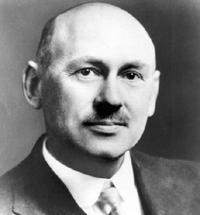 Robert H. Goddard
An American scientist, Goddard is recognized as a pioneer of controlled, liquid-fueled rocketry. In 1919, he published a book proposing a rocket that might reach the moon. He received little recognition during his own lifetime, but would eventually come to be called one of the "fathers of modern rocketry".
Robert H. Goddard
An American scientist, Goddard is recognized as a pioneer of controlled, liquid-fueled rocketry. In 1919, he published a book proposing a rocket that might reach the moon. He received little recognition during his own lifetime, but would eventually come to be called one of the "fathers of modern rocketry".
 Herman J. Oberth
Oberth sparked ideas in many space-minded people, amateur and professional, with his 92-page pamphlet, "The Rocket into Interplanetary Space", written in 1923. He later aided in wartime rocket research in Germany, and in 1955 joined the staff of America's Redstone Arsenal.
Herman J. Oberth
Oberth sparked ideas in many space-minded people, amateur and professional, with his 92-page pamphlet, "The Rocket into Interplanetary Space", written in 1923. He later aided in wartime rocket research in Germany, and in 1955 joined the staff of America's Redstone Arsenal.
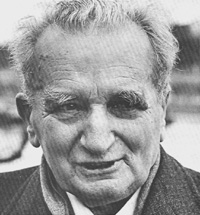 Theodore von Karman
Once called a "genius's genius", this Hungarian aeronautical expert was a great theoretician, practical scientist and industrial organizer. He came to the United States in 1930 and was responsible for many advances in the development of high-speed aircraft and rockets.
Theodore von Karman
Once called a "genius's genius", this Hungarian aeronautical expert was a great theoretician, practical scientist and industrial organizer. He came to the United States in 1930 and was responsible for many advances in the development of high-speed aircraft and rockets.
 Wernher von Braun
At the age of 20, Von Braun was hired as the German army's first civilian employee in rocket research and by age 25 was the technical director of all such research in Germany. He presided over the development of the V-2 rocket. After the war he moved to the U.S. and was a leading figure in America's space program.
Wernher von Braun
At the age of 20, Von Braun was hired as the German army's first civilian employee in rocket research and by age 25 was the technical director of all such research in Germany. He presided over the development of the V-2 rocket. After the war he moved to the U.S. and was a leading figure in America's space program.
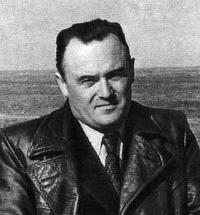 Sergei P. Korolev
Trained as an aeronautical engineer, Korolev became the head Soviet rocket engineer and designer during the Space Race between the United States and the Soviet Union. Korolev's pivotal role in the Soviet space program was kept a closely-guarded secret until after his death.
Sergei P. Korolev
Trained as an aeronautical engineer, Korolev became the head Soviet rocket engineer and designer during the Space Race between the United States and the Soviet Union. Korolev's pivotal role in the Soviet space program was kept a closely-guarded secret until after his death.
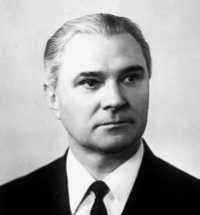 Valentin P. Glushko
A Soviet engineer of Ukrainian descent, Glushko was one of the principal designers of early Soviet spacecraft and rockets. In 1946 he became the chief designer of his own bureau, which would play a prominent role of the development of rocket engines in the Soviet Union.
Valentin P. Glushko
A Soviet engineer of Ukrainian descent, Glushko was one of the principal designers of early Soviet spacecraft and rockets. In 1946 he became the chief designer of his own bureau, which would play a prominent role of the development of rocket engines in the Soviet Union.
 William H. Pickering
Born in New Zealand, Pickering was a central figure in the U.S. space program and former director of NASA's Jet Propulsion Laboratory. He directed the effort to build Explorer 1 and remained at JPL, the center responsible for NASA's deep space missions, until 1976.
William H. Pickering
Born in New Zealand, Pickering was a central figure in the U.S. space program and former director of NASA's Jet Propulsion Laboratory. He directed the effort to build Explorer 1 and remained at JPL, the center responsible for NASA's deep space missions, until 1976.
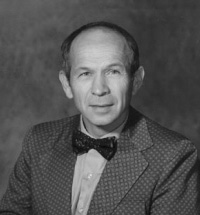 Maxime A. Faget
An American engineer, who in 1958 became part of the Space Task Group. Dr. Faget designed the original spacecraft for Project Mercury and is credited with contributing to the designs of every U.S. human spacecraft from Mercury to the Space Shuttle.
Maxime A. Faget
An American engineer, who in 1958 became part of the Space Task Group. Dr. Faget designed the original spacecraft for Project Mercury and is credited with contributing to the designs of every U.S. human spacecraft from Mercury to the Space Shuttle.
 V2 Rocket
A V2 rocket is towed to the launch pad at White Sands Proving Ground on May 10, 1946. V2 rockets like this one were the progenitor of the rocket race that developed during the Cold War between the United States and Soviet Union.
V2 Rocket
A V2 rocket is towed to the launch pad at White Sands Proving Ground on May 10, 1946. V2 rockets like this one were the progenitor of the rocket race that developed during the Cold War between the United States and Soviet Union.
 Chuck Yeager / XS-1
U.S. Air Force Captain Chuck Yeager poses in front of the Bell XS-1 rocket research plane that propelled him to a speed of Mach 1.06 on October 14, 1947, making him the first man to break the "sound barrier".
Chuck Yeager / XS-1
U.S. Air Force Captain Chuck Yeager poses in front of the Bell XS-1 rocket research plane that propelled him to a speed of Mach 1.06 on October 14, 1947, making him the first man to break the "sound barrier".
 Sputnik 1
Sputnik 1 ushered in the space age on October 4, 1957. It consisted of a 58 cm diameter sphere with four whip-like antennae and two radios transmitters that sent out a series of beeps. Sputnik 1 incinerated upon reentry on January 3, 1958.
Sputnik 1
Sputnik 1 ushered in the space age on October 4, 1957. It consisted of a 58 cm diameter sphere with four whip-like antennae and two radios transmitters that sent out a series of beeps. Sputnik 1 incinerated upon reentry on January 3, 1958.
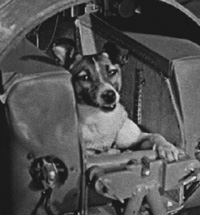 Laika
Laika, a six-kilogram female mongrel, became the first living creature to orbit the Earth on November 3, 1957 in Sputnik 2. Knowingly sent to her death, Laika survived in orbit for several hours before succumbing to stress and overheating.
Laika
Laika, a six-kilogram female mongrel, became the first living creature to orbit the Earth on November 3, 1957 in Sputnik 2. Knowingly sent to her death, Laika survived in orbit for several hours before succumbing to stress and overheating.
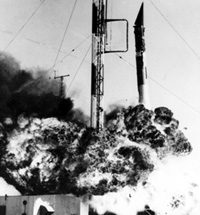 Vanguard 1A
America's first attempt to answer the Soviet Union's Sputnik ended in this fiery explosion December 6, 1957 on a Cape Canaveral launch pad. After the failure, the U.S. Army was given the go ahead to launch a satellite using Von Braun's Jupiter-C rocket.
Vanguard 1A
America's first attempt to answer the Soviet Union's Sputnik ended in this fiery explosion December 6, 1957 on a Cape Canaveral launch pad. After the failure, the U.S. Army was given the go ahead to launch a satellite using Von Braun's Jupiter-C rocket.
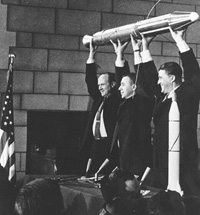 Explorer 1
William Pickering, James Van Allen, and Wernher von Braun display a model of America's first satellite, Explorer 1, at a press conference February 1, 1958. Explorer 1 discovered what would become known as the Van Allen Radiation Belts.
Explorer 1
William Pickering, James Van Allen, and Wernher von Braun display a model of America's first satellite, Explorer 1, at a press conference February 1, 1958. Explorer 1 discovered what would become known as the Van Allen Radiation Belts.
 Vostok 1
An R-7 missile lifts Vostok 1 off the launch pad at Tyuratam on April 12, 1961 carrying cosmonaut Yuri Gagarin. Vostok 1 completed one orbit of Earth, landing in Russia 108 minutes after launch. Gagarin ejected after reentry and descended under his own parachute.
Vostok 1
An R-7 missile lifts Vostok 1 off the launch pad at Tyuratam on April 12, 1961 carrying cosmonaut Yuri Gagarin. Vostok 1 completed one orbit of Earth, landing in Russia 108 minutes after launch. Gagarin ejected after reentry and descended under his own parachute.
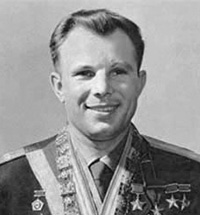 Yuri A. Gagarin
As an air force lieutenant, Gagarin was selected in the first group of Soviet cosmonauts. On April 12, 1961, Gagarin became the first human being to travel into space in his Vostok 1 spacecraft. While in orbit he was prompted to the rank of Major.
Yuri A. Gagarin
As an air force lieutenant, Gagarin was selected in the first group of Soviet cosmonauts. On April 12, 1961, Gagarin became the first human being to travel into space in his Vostok 1 spacecraft. While in orbit he was prompted to the rank of Major.
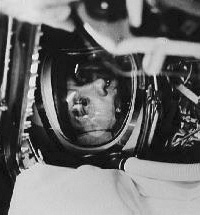 Alan Shepard / MR-3
Astronaut Alan Shepard reclines in the couch of his tiny Mercury capsule, named "Freedom 7". Shepard became the first American in space on May 5, 1961 when his 15-minute suborbital flight carried him to an altitude of 187 km and a range of 486 km.
Alan Shepard / MR-3
Astronaut Alan Shepard reclines in the couch of his tiny Mercury capsule, named "Freedom 7". Shepard became the first American in space on May 5, 1961 when his 15-minute suborbital flight carried him to an altitude of 187 km and a range of 486 km.
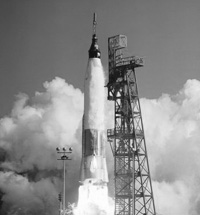 Mercury-Atlas 6
Sitting atop an Atlas missile, John Glenn's Mercury capsule is rocketed into space from Cape Canaveral on February 20, 1962. This first American manned orbital flight completed three revolutions and splashed down in the Atlantic Ocean after 4 hours 55 minutes.
Mercury-Atlas 6
Sitting atop an Atlas missile, John Glenn's Mercury capsule is rocketed into space from Cape Canaveral on February 20, 1962. This first American manned orbital flight completed three revolutions and splashed down in the Atlantic Ocean after 4 hours 55 minutes.
 John H. Glenn, Jr.
One of the original Mercury astronauts, Glenn became the first American to orbit the Earth on February 20, 1962 in his spacecraft "Friendship 7", turning him into an American hero. He later went into politics and served as a U.S. Senator from the state of Ohio.
John H. Glenn, Jr.
One of the original Mercury astronauts, Glenn became the first American to orbit the Earth on February 20, 1962 in his spacecraft "Friendship 7", turning him into an American hero. He later went into politics and served as a U.S. Senator from the state of Ohio.
 Telstar 1
Launched July 10, 1962, Telstar 1 was the world's first commercial communications satellite. It relayed the first transatlantic television transmissions and ushered in a new age of global communications and the benevolent use of space.
Telstar 1
Launched July 10, 1962, Telstar 1 was the world's first commercial communications satellite. It relayed the first transatlantic television transmissions and ushered in a new age of global communications and the benevolent use of space.
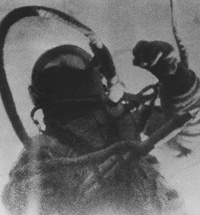 Voskhod 2
This ghostly image is of cosmonaut Alexei Leonov outside his Voskhod 2 spacecraft on March 18, 1965, becoming the first human to walk in space. American Ed White would match the feat less than 3 months later during Gemini 4.
Voskhod 2
This ghostly image is of cosmonaut Alexei Leonov outside his Voskhod 2 spacecraft on March 18, 1965, becoming the first human to walk in space. American Ed White would match the feat less than 3 months later during Gemini 4.
 Mariner 4
The eleventh of 21 complete (plus one partial) TV pictures transmitted by Mariner 4 during its July 14, 1965 flyby of Mars. These first close-up images of the Martian surface revealed a vast, barren wasteland of craters strewn about a carpet of sand.
Mariner 4
The eleventh of 21 complete (plus one partial) TV pictures transmitted by Mariner 4 during its July 14, 1965 flyby of Mars. These first close-up images of the Martian surface revealed a vast, barren wasteland of craters strewn about a carpet of sand.
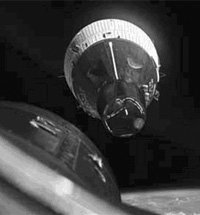 Gemini 6 & 7
Here we see the Gemini 7 spacecraft from the window of Gemini 6 during station keeping on December 15, 1965. This was the first rendezvous of two space vehicles, a crucial step in the process of learning to maneuver in space.
Gemini 6 & 7
Here we see the Gemini 7 spacecraft from the window of Gemini 6 during station keeping on December 15, 1965. This was the first rendezvous of two space vehicles, a crucial step in the process of learning to maneuver in space.
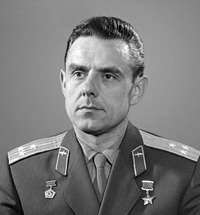 Vladimir M. Komarov
On his second flight into space, Soyuz 1, Komarov became the first human to die on a space mission April 24, 1967 when his parachutes became entangled. The flight proceeded due to political pressure despite engineering objections.
Vladimir M. Komarov
On his second flight into space, Soyuz 1, Komarov became the first human to die on a space mission April 24, 1967 when his parachutes became entangled. The flight proceeded due to political pressure despite engineering objections.
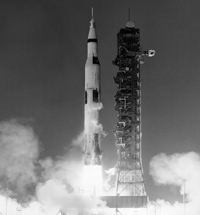 Apollo 8
Apollo 8 lifts off Kennedy Space Center pad 39-A on December 21, 1968. The Saturn V rocket, the largest ever flown, sent the first human beings beyond Earth orbit and to the Moon. The spacecraft completed ten orbits of the Moon and returned to Earth on December 27.
Apollo 8
Apollo 8 lifts off Kennedy Space Center pad 39-A on December 21, 1968. The Saturn V rocket, the largest ever flown, sent the first human beings beyond Earth orbit and to the Moon. The spacecraft completed ten orbits of the Moon and returned to Earth on December 27.
 Earthrise
This photograph, taken December 24, 1968 by astronaut Bill Anders, shows the first view of Earth by human beings from the Moon. It is one of the most famous and inspiring photos in the history of manned space exploration.
Earthrise
This photograph, taken December 24, 1968 by astronaut Bill Anders, shows the first view of Earth by human beings from the Moon. It is one of the most famous and inspiring photos in the history of manned space exploration.
 Apollo 11
The Apollo 11 lunar module "Eagle" as viewed from the command module "Columbia" after undocking on July 20, 1969. The ungainly spacecraft would carry astronauts Neil Armstrong and Buzz Aldrin to the surface of the Moon, while Michael Collins remained in orbit.
Apollo 11
The Apollo 11 lunar module "Eagle" as viewed from the command module "Columbia" after undocking on July 20, 1969. The ungainly spacecraft would carry astronauts Neil Armstrong and Buzz Aldrin to the surface of the Moon, while Michael Collins remained in orbit.
 Neil A. Armstrong
Selected as an astronaut in 1962, Armstrong commanded the Gemini 8 and Apollo 11 missions. On July 20, 1969 he guided his lunar module "Eagle" to the first manned landing on the Moon. He is the first human being to set foot upon the lunar surface.
Neil A. Armstrong
Selected as an astronaut in 1962, Armstrong commanded the Gemini 8 and Apollo 11 missions. On July 20, 1969 he guided his lunar module "Eagle" to the first manned landing on the Moon. He is the first human being to set foot upon the lunar surface.
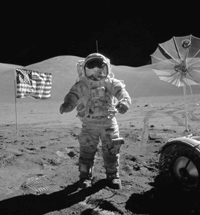 Apollo 17
Apollo 17 commander, and last man to have walked on the Moon, Gene Cernan pauses for Jack Schmitt to take this photo. The two astronauts explored the Moon's Taurus-Littrow Valley for three days, lifting off on December 14, 1972. To the right is the lunar roving vehicle.
Apollo 17
Apollo 17 commander, and last man to have walked on the Moon, Gene Cernan pauses for Jack Schmitt to take this photo. The two astronauts explored the Moon's Taurus-Littrow Valley for three days, lifting off on December 14, 1972. To the right is the lunar roving vehicle.
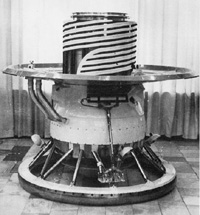 Venera 9
The Venera 9 lander was the third Soviet spacecraft to successfully reach the surface of Venus and transmit data, on October 22, 1975. The lander operated for 53 minutes after touchdown and became the first spacecraft to return an image from the surface of another planet.
Venera 9
The Venera 9 lander was the third Soviet spacecraft to successfully reach the surface of Venus and transmit data, on October 22, 1975. The lander operated for 53 minutes after touchdown and became the first spacecraft to return an image from the surface of another planet.
 Voyager 1
Voyager 1 captured this image of Saturn and its rings on November 16, 1980 four days after closest approach, from a distance of 5.3 million kilometers. Voyager remains NASA's most successful planetary mission as measured by total number of scientific discoveries.
Voyager 1
Voyager 1 captured this image of Saturn and its rings on November 16, 1980 four days after closest approach, from a distance of 5.3 million kilometers. Voyager remains NASA's most successful planetary mission as measured by total number of scientific discoveries.
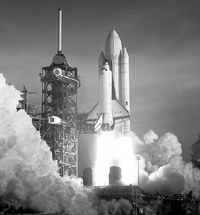 Columbia, STS-1
The Space Shuttle "Columbia" lifts off from Kennedy Space Center on April 12, 1981. STS-1 was the inaugural flight of the Space Transportation System. Columbia's 28th flight would end tragically when, on February 1, 2003, she would break apart during reentry resulting in the death of her crew.
Columbia, STS-1
The Space Shuttle "Columbia" lifts off from Kennedy Space Center on April 12, 1981. STS-1 was the inaugural flight of the Space Transportation System. Columbia's 28th flight would end tragically when, on February 1, 2003, she would break apart during reentry resulting in the death of her crew.
 Mir
The Russian space station "Mir" was launched February 20, 1986 and, except for two short periods, was continuously occupied until August 1999. The journey of the 15-year-old space station came to an end on March 23, 2001 when it reentered and fell into the Pacific Ocean.
Mir
The Russian space station "Mir" was launched February 20, 1986 and, except for two short periods, was continuously occupied until August 1999. The journey of the 15-year-old space station came to an end on March 23, 2001 when it reentered and fell into the Pacific Ocean.
 Hubble Space Telescope
The Hubble Space Telescope orbits 569 km above the Earth in this February 1997 photo taken during the STS-82 servicing mission. Launched in 1990, HST has become one of the most important telescopes in history and responsible for many ground-breaking observations.
Hubble Space Telescope
The Hubble Space Telescope orbits 569 km above the Earth in this February 1997 photo taken during the STS-82 servicing mission. Launched in 1990, HST has become one of the most important telescopes in history and responsible for many ground-breaking observations.
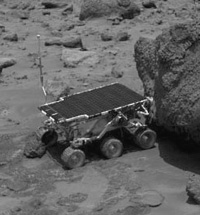 Pathfinder
NASA's Pathfinder mission landed on Mars July 4, 1997. Seen here is the 16-kilogram microrover "Sojourner", analyzing a rock nicknamed "Yogi". Pathfinder transmitted data for 83 Martian days (sols) with final contact occurring September 27.
Pathfinder
NASA's Pathfinder mission landed on Mars July 4, 1997. Seen here is the 16-kilogram microrover "Sojourner", analyzing a rock nicknamed "Yogi". Pathfinder transmitted data for 83 Martian days (sols) with final contact occurring September 27.
 Shenzhou 5
Chinese taikonaut Yang Liwei waves from inside his Shenzhou 5 space capsule after returning from a fourteen orbit flight on October 15, 2003. The mission marked the first manned flight for China, the third nation to send a human into space.
Shenzhou 5
Chinese taikonaut Yang Liwei waves from inside his Shenzhou 5 space capsule after returning from a fourteen orbit flight on October 15, 2003. The mission marked the first manned flight for China, the third nation to send a human into space.
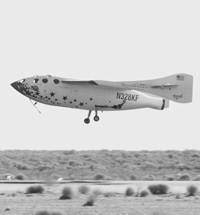 SpaceShipOne
Rocket plane SpaceShipOne, piloted by Michael Melvill, glides to a landing in California on June 21, 2004 after completing a flight to over 100 kilometers altitude. It is the first privately funded non-government venture to pass the edge of space.
SpaceShipOne
Rocket plane SpaceShipOne, piloted by Michael Melvill, glides to a landing in California on June 21, 2004 after completing a flight to over 100 kilometers altitude. It is the first privately funded non-government venture to pass the edge of space.
 Cassini-Huygens
After separating from the Cassini orbiter, ESA's Huygens probe descended to the surface of Titan on January 14, 2005. This mosaic of three frames provides unprecedented detail of a high ridge area including the flow down into a major river channel from different sources.
Cassini-Huygens
After separating from the Cassini orbiter, ESA's Huygens probe descended to the surface of Titan on January 14, 2005. This mosaic of three frames provides unprecedented detail of a high ridge area including the flow down into a major river channel from different sources.
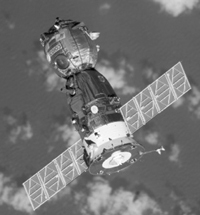 Soyuz
Backdropped by the Earth, Soyuz TMA-7 departs the International Space Station on April 8, 2006. The Soyuz spacecraft has been the workhorse of the Soviet and Russian manned space programs since 1968. It has gone through several upgrades since its earliest version.
Soyuz
Backdropped by the Earth, Soyuz TMA-7 departs the International Space Station on April 8, 2006. The Soyuz spacecraft has been the workhorse of the Soviet and Russian manned space programs since 1968. It has gone through several upgrades since its earliest version.
 Eileen M. Collins
A retired U.S. Air Force Colonel, Collins was a NASA astronaut 1991-2006. Flying four space shuttle missions, she served twice each as Pilot and Commander, the first woman to be assigned either position on a shuttle flight.
Eileen M. Collins
A retired U.S. Air Force Colonel, Collins was a NASA astronaut 1991-2006. Flying four space shuttle missions, she served twice each as Pilot and Commander, the first woman to be assigned either position on a shuttle flight.
|
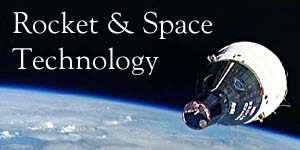

 Konstantin Tsiolkovsky
Konstantin Tsiolkovsky Robert H. Goddard
Robert H. Goddard Herman J. Oberth
Herman J. Oberth Theodore von Karman
Theodore von Karman Wernher von Braun
Wernher von Braun Sergei P. Korolev
Sergei P. Korolev Valentin P. Glushko
Valentin P. Glushko William H. Pickering
William H. Pickering Maxime A. Faget
Maxime A. Faget V2 Rocket
V2 Rocket Chuck Yeager / XS-1
Chuck Yeager / XS-1 Sputnik 1
Sputnik 1 Laika
Laika Vanguard 1A
Vanguard 1A Explorer 1
Explorer 1 Vostok 1
Vostok 1 Yuri A. Gagarin
Yuri A. Gagarin Alan Shepard / MR-3
Alan Shepard / MR-3 Mercury-Atlas 6
Mercury-Atlas 6 John H. Glenn, Jr.
John H. Glenn, Jr. Telstar 1
Telstar 1 Voskhod 2
Voskhod 2 Mariner 4
Mariner 4 Gemini 6 & 7
Gemini 6 & 7 Vladimir M. Komarov
Vladimir M. Komarov Apollo 8
Apollo 8 Earthrise
Earthrise Apollo 11
Apollo 11 Neil A. Armstrong
Neil A. Armstrong Apollo 17
Apollo 17 Venera 9
Venera 9 Voyager 1
Voyager 1 Columbia, STS-1
Columbia, STS-1 Mir
Mir Hubble Space Telescope
Hubble Space Telescope Pathfinder
Pathfinder Shenzhou 5
Shenzhou 5 SpaceShipOne
SpaceShipOne Cassini-Huygens
Cassini-Huygens Soyuz
Soyuz Eileen M. Collins
Eileen M. Collins